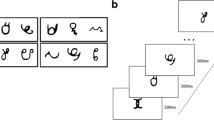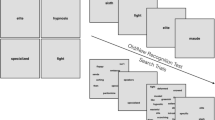Abstract
Do visual cues such as size, color, and number facilitate sequential recall in orangutans and human children? In Experiment 1, children and adult orangutans solved two types of sequences, arbitrary (unrelated pictures) and meaningful (pictures varied along a spectrum according to the size, color, or number of items shown), in a touchscreen paradigm. It was found that visual cues did not increase the percentage of correct responses for either children or orangutans. In order to demonstrate that the failure to spontaneously seriate along these dimensions was not due to a general inability to perceive the dimensions nor to an inability to seriate items, in Experiment 2, orangutans were trained on one type of sequence and tested on novel sequences organized according to the same rule (i.e., pictures varied on the number spectrum only). The orangutans performed significantly better on novel meaningful sequences in this task than on novel arbitrary sequences. These results indicate that, while orangutans and human children share the ability to learn how to order items according to their size, color, or number, both orangutans and humans lack a cognitive propensity to spontaneously (i.e., without prior training or enculturation) order multiple items by size, color, or number.







Similar content being viewed by others
References
Agrillo C, Bisazza A (2014) Spontaneous versus trained numerical abilities. A comparison between the two main tools to study numerical competence in non-human animals. J Neurosci Methods 234:82–91
Anderson US, Cordes S (2013) 1 < 2 and 2 < 3: non-linguistic appreciations of numerical order. Front Psychol 4:1–13
Anderson US, Stoinski TS, Bloomsmith MA, Maple TL (2007) Relative numerousness judgment and summation in young, middle-aged, and older adult orangutans (Pongo pygmaeus abelii and Pongo pygmaeus pygmaeus). J Comp Psychol 121:1–11
Bauer PJ, Mandler JM (1989) One thing follows another; effects of temporal structure on 1- to 2-year-olds’ recall of events. Dev Psychol 25:197–206
Bonanni R, Natoli E, Cafazzo S, Valsecchi P (2011) Free-ranging dogs assess the quantity of opponents in intergroup conflicts. Anim Cogn 14:103–115
Brannon EM (2002) The development of ordinal numerical knowledge in infancy. Cognition 83:223–240
Brannon EM, Terrace HS (2000) Representation of the numerosities 1–9 by rhesus macaques (Macaca mulatta). J Exp Psychol Anim Behav Process 26:31–49
Brannon EM, Van de Walle GA (2001) The development of ordinal numerical competence in young children. Cogn Psychol 43:53–81
Brannon EM, Cantlon JF, Terrace HS (2006) The role of reference points in ordinal numerical comparisons by rhesus macaques (Macaca mulatta). J Exp Psychol Anim Behav Process 32:120–134
Cantlon JF, Brannon EM (2007) How much does number matter to a monkey (Macaca mulatta)? J Exp Psychol Anim Behav Process 33:32–41
Cantlon JF, Platt ML, Brannon EM (2009) Beyond the number domain. Trends Cogn Sci 13(2):83–91. doi:10.1016/j.tics.2008.11.007
Conrad R (1971) The chronology of the development of covert speech in children. Dev Psychol 5(3):398–405
Corsi PM (1972) Human memory and the medial temporal region of the brain. PhD Dissertation, McGill University, Montréal, Canada
D’Amato MR, Colombo M (1988) Representation of serial order in monkeys (Cebus apella). J Exp Psychol Anim Behav Process 14:131–139
Davis H, Pérusse R (1988) Numerical competence in animals: definitional issues, current evidence, and a new research agenda. Behav Brain Sci 11:561–579
Dominy NJ, Lucas PW (2001) Ecological importance of trichromatic vision to primates. Nature 410(6826):363–366. doi:10.1038/35066567
Guyla M, Colombo M (2004) The ontogeny of serial-order behavior in humans (Homo sapiens): representation of a list. J Comp Psychol 118:71–81
Harris EH, Beran MJ, Washburn DA (2007) Ordinal-list integration for symbolic, arbitrary, and analog stimuli by rhesus macaques (Macaca mulatta). J Gen Psychol 134:183–197
Hull CL (1952) A behavior system: an introduction to behavior theory concerning the individual organism. Yale University Press, New Haven
Hulse SF (2002) Perspectives on comparative cognition: past, present, and future. In: Fountain S (ed) Animal cognition and sequential behavior. Kluwer Academic Publishing, Boston, pp 3–19
Inoue S, Matsuzawa T (2007) Working memory of numerals in chimpanzees. Curr Biol 17:R1004–R1005
Jacobs GH, Williams GA (2000) The prevalence of defective color vision in Old World monkeys and apes. Color Res Appl 26S:123–127
Lucas PW, Dominy NJ, Riba-Hernandez P, Stoner KE, Yamashita N, Loria-Calderon E, Petersen-Pereira W, Rojas-Duran Y, Salas-Pena R, Solis-Madrigal S, Osorio D, Darvell BW (2003) Evolution and function of routine trichromatic vision in primates. Evolution 57(11):2636–2643
Maslow AH (1933) Comparative behavior of primates. VI. Food preferences of primates. J Comp Psychol 16:187–197. doi:10.1037/h0070404
Ohshiba N (1997) Memorization of serial items by Japanese monkeys, a chimpanzee, and humans. Jpn Psychol Res 39:236–252
Paz-y-Miño G, Bond AB, Kamil AC, Balda RP (2004) Pinyon jays use transitive inference to predict social dominance. Nature 430:778–781
Pfuhl G, Biegler R (2012) Ordinality and novel sequence learning in jackdaws. Anim Cogn 15:833–849
Piaget J, Inhelder B (1964) The early growth of logic in the child. Harper & Row, Publishers, New York
Pinker S (1991) Rules of language. Science 253:530–535
Pinker S (1994) The language instinct. Harper Collins Publishers, New York
Regan BC, Julliot C, Simmen B, Vienot F, Charles-Dominique P, Mollon JD (2001) Fruits, foliage and the evolution of primate colour vision. Philos Trans R Soc Lond B Biol Sci 356(1407):229–283. doi:10.1098/rstb.2000.0773
Remis MJ (2007) Food preferences among captive Western gorillas (Gorilla gorilla gorilla) and chimpanzees (Pan troglodytes). Int J Primatol 23:231–249
Scarf D, Colombo M (2011) Knowledge of the ordinal position of list items in pigeons. J Exp Psychol Anim Behav Process 37:483–487
Shettleworth SJ (2010) Cognition, evolution, and behavior, 2nd edn. Oxford University Press, New York
Subiaul F, Cantlon JF, Holloway RL, Terrace HS (2004) Cognitive imitation in rhesus macaques. Science 305:407–410
Subiaul F, Romansky K, Cantlon JF, Klein T, Terrace H (2007) Cognitive imitation in 2-year-old children (Homo sapiens): a comparison with rhesus monkeys (Macaca mulatta). Anim Cogn 10:369–375. doi:10.1007/s10071-006-0070-3
Subiaul F, Anderson S, Brandt J, Elkins J (2012) Multiple imitation mechanisms in children. Dev Psychol 48:1165–1179
Swartz KB, Chen S, Terrace HS (1991) Serial learning by rhesus monkeys: I. Acquisition and retention of multiple four-item lists. J Exp Psychol Anim Behav Process 17:396–410
Swartz KB, Chen S, Terrace HS (2000) Serial learning by rhesus monkeys: II. Learning four-item lists by trial and error. J Exp Psychol Anim Behav Process 26:274–285
Terrace HS (1991) Chunking during serial learning by a pigeon: I. Basic evidence. J Exp Psychol Anim Behav Process 17:81–93
Terrace H (2001) Chunking and serially organized behavior in pigeons, monkeys and humans. In: Cook RG (ed) Avian visual cognition [On-line]. www.pigeon.psy.tufts.edu/avc/terrace/
Terrace H (2002) The comparative psychology of chunking. In: Fountain S (ed) Animal cognition and sequential behavior. Kluwer Academic Publishing, Boston, pp 23–56
Terrace HS (2005) The simultaneous chain: a new approach to serial learning. Trends Cogn Sci 9:202–210
Terrace HS, McGonigle B (1994) Memory and representation of serial order by children, monkeys, and pigeons. Curr Dir Psychol Sci 3:180–185
Terrace HS, Son LK, Brannon EM (2003) Serial expertise of rhesus macaques. Psychol Sci 14:66–73
Xu F, Spelke ES (2000) Large number discrimination in 6-month-old infants. Cognition 74:B1–B11
Acknowledgments
The authors acknowledge Chikako Suda-King and the Zookeepers at Smithsonian’s National Zoological Park for facilitating data collection with the great apes, and the research assistants from GWU who helped carry out data collection with children.
Author information
Authors and Affiliations
Corresponding author
Ethics declarations
The portion of the research involving human children was approved by the George Washington University Institutional Review Board. All procedures performed in studies involving human participants were in accordance with the ethical standards of the IRB and with the 1964 Helsinki Declaration and its later amendments or comparable ethical standards. The portion of the research involving orangutans was approved by the George Washington University IACUC and Smithsonian Institution ACUC. All applicable international, national, and/or institutional guidelines for the care and use of animals were followed. All procedures performed in studies involving animals were in accordance with the ethical standards of the institution at which the studies were conducted.
Conflict of interest
The authors declare that they have no conflict of interest.
Rights and permissions
About this article
Cite this article
Renner, E., Price, E.E. & Subiaul, F. Sequential recall of meaningful and arbitrary sequences by orangutans and human children: Does content matter?. Anim Cogn 19, 39–52 (2016). https://doi.org/10.1007/s10071-015-0911-z
Received:
Revised:
Accepted:
Published:
Issue Date:
DOI: https://doi.org/10.1007/s10071-015-0911-z




